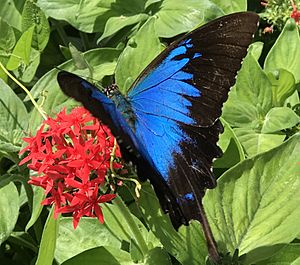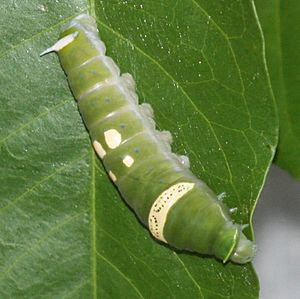Ulysses butterfly facts for kids
The Ulysses butterfly, also known as the Blue emperor, is a beautiful, large butterfly. Its scientific name is Papilio ulysses. You can find this amazing butterfly in places like Australia, Indonesia, Papua New Guinea, and the Solomon Islands.
The size of the Ulysses butterfly can change a bit depending on where it lives. In Queensland, Australia, its wings can spread about 10.5 centimeters (about 4 inches) wide. This butterfly is so special that it's used as a symbol for tourism in Queensland!
Quick facts for kids Ulysses butterfly |
|
|---|---|
 |
|
| Papilio ulysses, Port Douglas Australia | |
| Scientific classification | |
| Kingdom: | |
| Phylum: | |
| Class: | |
| Order: | |
| Family: | |
| Genus: |
Papilio
|
| Species: |
P. ulysses
|
| Binomial name | |
| Papilio ulysses Linnaeus, 1758
|
|
| Subspecies | |
|
|
Contents
What's in a Name?
The name Ulysses comes from an old Roman name for a famous Greek hero named Odysseus. He is the main character in a very old Greek story called the Odyssey.
Where Do They Live?
The Ulysses butterfly lives in parts of north-eastern Australia, especially eastern Queensland. You can also find it in New Guinea, the Maluku Islands, the Bismarck Archipelago, and the north-western Solomon Islands. A similar butterfly, Papilio montrouzieri, lives in New Caledonia.
How to Spot a Ulysses Butterfly
The Ulysses butterfly usually has a wingspan of about 14 centimeters (about 5.5 inches). However, its size can vary a bit depending on the specific type, or subspecies, with western types being the largest.
Amazing Colors
The top side of its wings is a bright, shiny electric blue. This amazing color is not from paint or dye! It comes from the tiny structures on the butterfly's scales, which reflect light in a special way. This is called structural colouration. The underside of its wings is a more plain black and brown.
Males vs. Females
You can tell the difference between male and female Ulysses butterflies. Females have small blue crescent shapes on the back, upper parts of their hindwings. Males, however, only have black in those areas.
Hiding and Flying
When the butterfly is resting, it hides its bright blue wings by folding them up. This shows the plainer brown underside, which helps it blend in with its surroundings. But when it flies, you can see its sudden, bright blue flashes from far away! Male Ulysses butterflies are very attracted to the color blue. Sometimes, they even mistake blue objects for other female butterflies!
Diet and Conservation
The Ulysses butterfly lives in tropical rainforest areas and even in some gardens in towns.
What They Eat
The young butterflies, called caterpillars, eat leaves from plants like kerosene wood, different types of Citrus trees, and Euodia trees.
Adult Ulysses butterflies like to drink nectar from the flowers of the pink flowered doughwood tree. This tree has bunches of small pink flowers that grow right from its branches.
Protecting the Butterflies
Even though the Ulysses butterfly is not currently in danger of disappearing, the Australian government asks people who breed them to have special permits. In the past, this butterfly faced some threats. But planting more pink flowered doughwood trees has helped their numbers grow.
However, if there are fewer Euodia trees, it could be a problem for these butterflies. Female butterflies love to lay their eggs on small Euodia trees, usually those up to 2 meters (about 6.5 feet) tall. The caterpillars also eat the leaves from these trees. So, having enough Euodia trees is very important for the Ulysses butterfly to survive.
Images for kids
See also
 In Spanish: Mariposa Ulises para niños
In Spanish: Mariposa Ulises para niños




